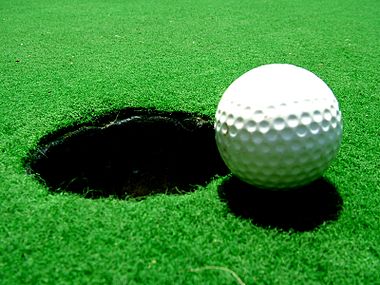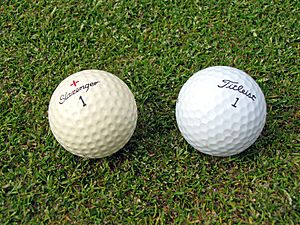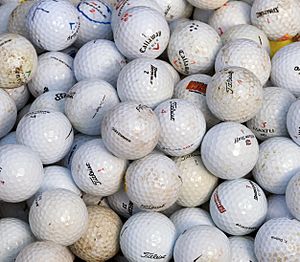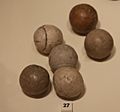Golf ball facts for kids
A golf ball is a special ball designed to be used in the game of golf.
Under the rules of golf, a golf ball has a mass no more than 1.620 oz (45.93 grams), has a diameter not less than 1.680 in (42.67 mm), and performs within specified velocity, distance, and symmetry limits. Like golf clubs, golf balls are subject to testing and approval by The R&A (formerly part of the Royal and Ancient Golf Club of St Andrews) and the United States Golf Association, and those that do not conform with regulations may not be used in competitions (Rule 5–1).
Contents
Regulations
The Rules of Golf, jointly governed by the R&A and the USGA, state in Appendix III that the diameter of a "conforming" golf ball cannot be any smaller than 1.680 inches (42.67 mm), and the weight of the ball may not exceed 1.620 ounces (45.93 g). The ball must also have the basic properties of a spherically symmetrical ball, generally meaning that the ball itself must be spherical and must have a symmetrical arrangement of dimples on its surface. Additional rules direct players and manufacturers to other technical documents published by the R&A and USGA with additional restrictions, such as radius and depth of dimples, maximum launch speed from test apparatus (generally defining the coefficient of restitution) and maximum total distance when launched from the test equipment.
In general, the governing bodies and their regulations seek to provide a relatively level playing field and maintain the traditional form of the game and its equipment, while not completely halting the use of new technology in equipment design.
Until 1990, it was permissible to use balls of less than 1.68 inches in diameter in tournaments under the jurisdiction of the R&A, which differed in its ball specifications rules from those of the USGA. This ball was commonly called a "British" ball, while the golf ball approved by the USGA was simply the "American ball". The smaller diameter gave the player a distance advantage, especially in high winds, as the smaller ball created a similarly smaller "wake" behind it.
Aerodynamics
When a golf ball is hit, the impact, which lasts less than a millisecond, determines the ball's velocity, launch angle and spin rate, all of which influence its trajectory and its behavior when it hits the ground.
A ball moving through air experiences two major aerodynamic forces, lift and drag. Dimpled balls fly farther than non-dimpled balls due to the combination of these two effects.

•2: attached flow (Stokes flow) and steady separated flow,
•3: separated unsteady flow, having a laminar flow boundary layer upstream of the separation, and producing a vortex street,
•4: separated unsteady flow with a laminar boundary layer at the upstream side, before flow separation, with downstream of the sphere a chaotic turbulent wake,
•5: post-critical separated flow, with a turbulent boundary layer.
First, the dimples on the surface of a golf ball cause the boundary layer on the upstream side of the ball to transition from laminar to turbulent. The turbulent boundary layer is able to remain attached to the surface of the ball much longer than a laminar boundary and so creates a narrower low-pressure wake and hence less pressure drag. The reduction in pressure drag causes the ball to travel further.
Second, backspin generates lift by deforming the airflow around the ball, in a similar manner to an airplane wing. This is called the Magnus effect. The dimples on a golf ball deform the air around the ball quickly causing a turbulent airflow that results in more Magnus lift than a smooth ball would experience.
Backspin is imparted in almost every shot due to the golf club's loft (i.e., angle between the clubface and a vertical plane). A backspinning ball experiences an upward lift force which makes it fly higher and longer than a ball without spin.
Sidespin occurs when the clubface is not aligned perpendicularly to the intended direction of swing or ball-to-target line, leading to a lift force that makes the ball curve to one side or the other based on the direction of where the clubface is pointing at impact. The dimples allow both the sidespin to occur as well as to promote an angular upward lift. Some dimple designs are claimed to reduce the sidespin effects to provide a straighter ball flight.
To keep the aerodynamics optimal, the golf ball needs to be clean, including all dimples. Thus, it is advisable that golfers wash their balls whenever permissible by the rules of golf. Golfers can wash their balls manually using a wet towel or using a ball washer of some type.
Design
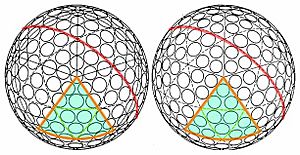
Dimples first became a feature of golf balls when English engineer and manufacturer William Taylor, co-founder of the Taylor-Hobson company, registered a patent for a dimple design in 1905. William Taylor had realized that golf players were trying to make irregularities on their balls, noticing that used balls were going further than new ones. Hence he decided to make systematic tests to determine what surface formation would give the best flight. He then developed a pattern consisting of regularly spaced indentations over the entire surface, and later tools to help producing such balls in series Other types of patterned covers were in use at about the same time, including one called a "mesh" and another named the "bramble", but the dimple became the dominant design due to "the superiority of the dimpled cover in flight".
Most modern golf balls have about 300–500 dimples, though there have been balls with more than 1000 dimples. The record holder was a ball with 1,070 dimples—414 larger ones (in four different sizes) and 656 pinhead-sized ones.
Officially sanctioned balls are designed to be as symmetrical as possible. This symmetry is the result of a dispute that stemmed from the Polara, a ball sold in the late 1970s that had six rows of normal dimples on its equator but very shallow dimples elsewhere. This asymmetrical design helped the ball self-adjust its spin axis during the flight. The USGA refused to sanction it for tournament play and, in 1981, changed the rules to ban aerodynamic asymmetrical balls. Polara's producer sued the USGA and the association paid US$1.375 million in a 1985 out-of-court settlement.
Golf balls are traditionally white, but are commonly available in other colors, some of which may assist with finding the ball when lost or when playing in low-light or frosty conditions. As well as bearing the maker's name or logo, balls are usually printed with numbers or other symbols to help players identify their ball.
Behaviour
Today, golf balls are manufactured using a variety of different materials, offering a range of playing characteristics to suit the player's abilities and desired flight and landing behaviours.
A key consideration is "compression", typically determined by the hardness of the ball's core layers. A harder "high-compression" ball will fly further because of the more efficient transfer of energy into the ball, but will also transmit more of a shock through the club to the player's hands (a "hard feel"). A softer "low-compression" ball will do just the opposite. Golfers typically prefer a softer feel, especially in the "short game", as the softer ball typically also has greater backspin with lofted irons. But drive distance is also of critical importance to many players wanting to get on the green in fewer strokes for a chance at a birdie or eagle, which a softer ball will reduce by wasting some of the impact energy in its compression.
Another consideration is "spin", affected by compression and by the cover material - a "high-spin" ball allows more of the ball's surface to contact the clubface at impact, allowing the grooves of the clubface to "grip" the ball and induce more backspin at launch. Backspin creates lift that can increase carry distance, and also provides "bite" which allows a ball to arrest its forward motion at the initial point of impact, bouncing straight up or even backwards, allowing for precision placement of the ball on the green with an approach shot. However, high-spin cover materials, typically being softer, are less durable which shortens the useful life of the ball, and backspin is not desirable on most long-distance shots, such as with the driver, as it causes the shot to "balloon" and then to bite on the fairway, when additional rolling distance is usually desired.
Lastly, the pattern of dimples plays a role. By regulation, the arrangement of the dimples on the ball must be as symmetrical as possible. However, the dimples don't all have to be the same size, nor be in a uniform distribution. This allows designers to arrange the dimple patterns in such a way that the resistance to spinning is lower along certain axes of rotation and higher along others. This causes the ball to "settle" into one of these low-resistance axes that (golfers hope) is close to parallel with the ground and perpendicular to the direction of travel, thereby eliminating "sidespin" induced by a slight miss-hit, which will cause the ball to curve off its intended flight path. A badly miss-hit ball will still curve, as the ball will settle into a spin axis that is not parallel with the ground which, much like an aircraft's wings, will cause the shot to bank either to the left or to the right.
Selection
There are many types of golf balls on the market, and customers often face a difficult decision. Golf balls are divided into two categories: recreational and advanced balls. Recreational balls are oriented toward the ordinary golfer, who generally have low swing speeds (80 miles per hour (130 km/h) or lower) and lose golf balls on the course easily. These balls are made of two layers, with the cover firmer than the core. Their low compression and side spin reduction characteristics suit the lower swing speeds of average golfers quite well. Furthermore, they generally have lower prices than the advanced balls, lessening the financial impact of losing a ball to a hazard or out of bounds.
Advanced balls are made of multiple layers (three or more), with a soft cover and firm core. They induce a greater amount of spin from lofted shots (wedges especially), as well as a sensation of softness in the hands in short-range shots. However, these balls require a much greater swing speed that only the physically strong players could carry out to compress at impact. If the compression of a golf ball does not match a golfer's swing speed, either the lack of compression or over-compression will occur, resulting in loss of distance. There are also many brands and colors to choose from, with colored balls and better brands generally being more expensive, making an individual's choice more difficult.
Practice/range balls
A practice ball or range ball is similar to a recreational golf ball, but is designed to be inexpensive, durable and have a shorter flight distance, while still retaining the principal behaviors of a "real" golf ball and so providing useful feedback to players. All of these are desirable qualities for use in an environment like a driving range, which may be limited in maximum distance, and must have many thousands of balls on-hand at any time that are each hit and mis-hit hundreds of times during their useful life.
To accomplish these ends, practice balls are typically harder-cored than even recreational balls, have a firmer, more durable cover to withstand the normal abrasion caused by a club's hitting surface, and are made as cheaply as possible while maintaining a durable, quality product. Practice balls are typically labelled with "PRACTICE" in bold lettering, and often also have one or more bars or lines printed on them, which allow players (and high-speed imaging aids) to see the ball's spin more easily as it leaves the tee or hitting turf.
Practice balls conform to all applicable requirements of the Rules of Golf, and as such are legal for use on the course, but as the hitting characteristics are not ideal, players usually opt for a better-quality ball for actual play.
Recycled balls
Players, especially novice and casual players, lose a large number of balls during the play of a round. Balls hit into water hazards, penalty areas, buried deeply in sand, and otherwise lost or abandoned during play are a constant source of litter that groundskeepers must contend with, and can confuse players during a round who may hit an abandoned ball (incurring a penalty by strict rules). An estimated 1.2 billion balls are manufactured every year and an estimated 300 million are lost in the US alone.
A variety of devices such as nets, harrows, sand rakes etc. have been developed that aid the groundskeeping staff in efficiently collecting these balls from the course as they accumulate. Once collected, they may be discarded, kept by the groundskeeping staff for their own use, repurposed on the club's driving range, or sold in bulk to a recycling firm. These firms clean and resurface the balls to remove abrasions and stains, grade them according to their resulting quality, and sell the various grades of playable balls back to golfers through retailers at a discount.
Used or recycled balls with obvious surface deformation, abrasion or other degradation are known informally as "shags", and while they remain useful for various forms of practice drills such as chipping, putting and driving, and can be used for casual play, players usually opt for used balls of higher quality, or for new balls, when playing in serious competition. Other grades are typically assigned letters or proprietary terms, and are typically differentiated by the cost and quality of the ball when new and the ability of the firm to restore the ball to "like-new" condition. The "top grade" balls are typically balls that are considered the current state of the art and, after cleaning and surfacing, are indistinguishable externally from a new ball sold by the manufacturer.
Markouts/X-Outs
In addition to recycled balls, casual golfers wishing to procure quality balls at a discount price can often purchase "X-outs". These are "factory seconds"; balls which have failed the manufacturer's quality control testing standards and which the manufacturer therefore does not wish to sell under its brand name. To avoid a loss of money on materials and labor, however, the balls which still generally conform to the Rules are marked to obscure the brand name (usually with a series of "X"s, hence the most common term "X-out"), packaged in generic boxes and sold at a deep discount.
Typically, the flaw that caused the ball to fail QC does not have a significant effect on its flight characteristics (balls with serious flaws are usually discarded outright at the manufacturing plant), and so these "X-outs" will often perform identically to their counterparts that have passed the company's QC. They are thus a good choice for casual play. However, because the balls have been effectively "disowned" for practical and legal purposes by their manufacturer, they are not considered to be the same as the brand-name balls on the USGA's published Conforming Golf Ball List. Therefore, when playing in a tournament or other event that requires the ball used by the player to appear on this list as a "condition of competition", X-outs of any kind are illegal.
Marking and personalisation
Golfers need to distinguish their ball from other players' to ensure that they do not play the wrong ball. This is often done by making a mark on the ball using a permanent marker pen such as a Sharpie. A wide number of markings are used; a majority of players either simply write their initial in a particular color, or color in a particular arrangement of the dimples on the ball. Many players make multiple markings so that at least one can be seen without having to lift the ball. Marking tools such as stamps and stencils are available to speed the marking process.
Alternatively, balls are usually sold pre-marked with the brand and model of golf ball, and also with a letter, number or symbol. This combination can usually (but not always) be used to distinguish a player's ball from other balls in play and from lost or abandoned balls on the course. Companies, country clubs and event organizers commonly have balls printed with their logo as a promotional tool, and some professional players are supplied with balls by their sponsors which have been custom-printed with something unique to that player (their name, signature, or a personal symbol).
Radio location
Golf balls with embedded radio transmitters to allow lost balls to be located were first introduced in 1973, only to be rapidly banned for use in competition. More recently RFID transponders have been used for this purpose, though these are also illegal in tournaments. This technology can however be found in some computerized driving ranges. In this format, each ball used at the range has an RFID with its own unique transponder code. When dispensed, the range registers each dispensed ball to the player, who then hits them towards targets in the range. When the player hits a ball into a target, they receive distance and accuracy information calculated by the computer. The use of this technology was first commercialized by World Golf Systems Group to create TopGolf, a brand and chain of computerized ranges now owned by International Management Company.
World records
Canadian long drive champion Jason Zuback broke the world ball speed record on an episode of Sport Science with a golf ball speed of 328 km/h (204 mph). The previous record of 302 km/h (188 mph) was held by José Ramón Areitio, a Jai Alai player.
Images for kids
See also
 In Spanish: Bola de golf para niños
In Spanish: Bola de golf para niños


